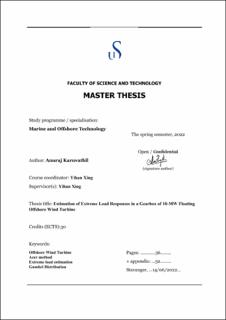| dc.description.abstract | This thesis studies the extreme load responses experienced by a 10-MW floating wind turbine situated in the North sea. With a plan to minimise fossil fuels and redefine the energy sector by adopting more safe, efficient, and cleaner solutions, countries have started investing in wind energy to harness the enormous untapped potential contained in the wind. Developing countries have begun building wind turbines to meet their energy needs. Countries started moving away from hydrocarbon and investing more in offshore wind turbines and solar energy parks to meet the expanding population needs and economy and reach net zero emission by 2050. The global average wind turbine size increased from 1.5-MW to 7.58-MW from 2000 to 2020. The future of wind turbines will be in 10-MW to 15-MW class wind turbines as the scientific research community has started to analyse more about the large offshore wind turbine(OWT). The gearbox is considered one of the most critical components in a wind turbine that drives a significant part of operating expenses. Reliability of the gearbox is often crucial for wind turbines which comes as a package with an efficient design and proper load estimation matching the ULS (Ultimate Limit State) condition. The costs of gearbox repair and upkeep and the costs of output losses associated with faulty gearboxes account for a significant portion of the operating costs of the offshore wind turbine. In this thesis, the accuracy and robustness of ACER (Average Conditional Exceedance Rate) as a tool are analysed to estimate extreme loads on the wind turbine gearbox and structure. This is done by analysing varying quantities of accessible data from the North Sea, where most large floating wind turbines are installed. The extreme loads estimated are compared with the Gumbel method under operating conditions of 8m/s, 12 m/s and 16m/s wind speed representing below, rated and above rated wind speed. It is vital to analyse the extreme loads under the dynamics operating condition and analyse the response in a fully coupled state. The aim is to show the accuracy and reliability of ACER in estimating the extreme load’s responses and 1,2 & 5 year return period of large OWT. The results show that the extreme loads’ responses on the 10-MW wind turbine gearbox and structure estimated by ACER gave more accurate and reliable values independent of other extreme value prediction methods like the Gumbel method. This study develops and estimates load responses in large OWT and guides the ultimate limit state load (ULS) calculation for 10-MW wind turbines. | |
